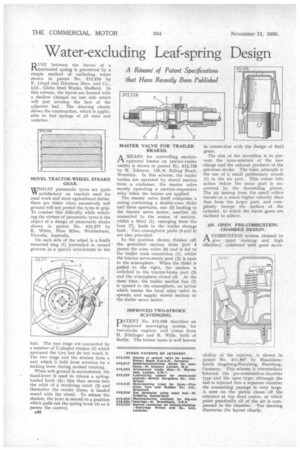Water-excluding Leaf-spring Design
Page 40

If you've noticed an error in this article please click here to report it so we can fix it.
RUST between the leaves of a laminated spring is prevented by a simple method of excluding water shown in patent No. 512,529 by F. Lloyd and Ibbotson Bros. and Co., Ltd., Globe Steel Works, Sheffield. In this scheme, the leaves are formed with a shallow channel on one side which will just envelop the face of the adjacent leaf. The drawing clearly shows the construction, which is applicable to leaf springs of all sizes and varieties,
NOVEL TRACTOR-WHEEL STRAKE GUAR.
WTHILST pneumatic tyres are quite W satisfactory on tractors used for road work and most agricultural duties, there are times when excessively soft ground will not permit the tyres to grip. To combat this difficulty while retaining the virtues of pneumatic tyres is the object of a design of retractable strake shown in patent No. 512,377 by E. White, Nine Miles, Wedderburn, Victoria, Australia.
On each side of the wheel is a freely mounted ring (1) journalled in turned grooves in a special attachment to the hub. The two rings are connected by a number of U-shaped strakes (2) which surround the tyre but do not touch it. The two rings and the strakes form a unit which is held from rotation by a locking lever during normal running.
When soft ground is encountered, the hand-lever is used to release a spring. loaded hook (4); this then moves into the orbit of a revolving catch (3) and thereafter the strake frame is hauled round with the wheel. To release the strakes, the lever is moved to a position which pulls out the spring hook (4) as it passes the control.
ASO MASTER VALVE FOR TRAILER BRAKES.
A MEANS for controlling suction1-1. operated brakes on tractor-trailer outfits is shown in patent No. 512,728 by M. Johnson, 134/6, Ealing Road, Wembley. In this scheme, the trailer brakes are operated by stored suction from a container, the master valve merely operating a suction-responsive relay when the brakes are applied.
The master valve itself comprises a casing containing a double-cone slider and three apertures, one (2) leading to the tractor servo motor, another (4) connected to the source of suction, whilst a third (1), emerging from the boss (7), leads to the trailer storage tank. Two atmospheric ports (3 and 5) are also provided.
In the position shown (brakes off) the generated suction from port 4 passes the cone valve (6) and is led to the trailer tank connection (1), whilst the tractor servo-motor port (2) is open to the atmosphere. When the slider is pulled to the right, the suction is switched to the tractor-brake port (2) and the atmosphere closed off. At the same time, the trailer suction line (7) is opened to the atmosphere, an action which causes the local relay valve to operate and supply stored suction to the trailer servo motor.
IMPROVED TWO-STROKE SCAVENGING.
PATENT No. 512,598 describes an improved scavenging system for two-stroke engines, and comes from H. Fottinger and R. Wille, both of Berlin. The former name is well known
in connection with the design of fluid gears.
The aim of the invention is to prevent the inter-mixture of the new charge and the exhaust products of the previous stroke. The basic principle is the use of a small preliminary nozzle (1) in the air port. This comes into action before the main port is uncovered by the descending piston. The air issuing from the small orifice travels at a much higher velocity than that from the larger port, and completely sweeps the surface of the cylinder, to which the burnt gases are inclined to adhere.
AN OPEN PRE-COMBUSTIONCHAMBER DESIGN.
A COMBUSTION system claimed to ft give quiet running and high efficiencY, combined with good acces
sibility of the injector, is shown in patent No. 511,997 by Maschinenfabrik Augsburg-Nurnberg, Nurnberg, Germany. This scheme is intermediate between the pre-combustion-chamber type and the open type; although the fuel is injected into a separate chamber the connecting passage is very large. A nose on the piston closes off the entrance at top dead centre, at which point practically all of the air is compressed in the chamber. The drawing illustrates the layout clearly.




























































